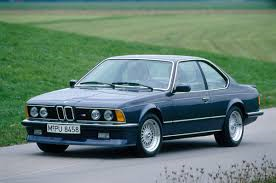-
Insurance
InsuranceAbout our productsLearn about insuringGet a quote Get current values, historical values, model history and more.
-
Valuation
ValuationHagerty valuation toolLook up a vehicle value Get current values, historical values, model history and more.
-
Events
EventsHagerty official eventsHagerty ClubhouseEvent calendar
-
Entertainment
EntertainmentMore to explore
- Portal login
1985 BMW 635CSi
Base Coupe 3.4 L
Vehicle values by condition
Fair
Condition 4
£7,200
#4 cars are daily drivers, with flaws visible to the naked eye. The chrome might have pitting or scratches, the windshield might be chipped.
Good
Condition 3
£11,100
#3 cars could possess some, but not all of the issues of a #4 car, but they will be balanced by other factors such as a fresh paint job or a new, correct interior.
Excellent
Condition 2
£24,900
#2 cars could win a local or regional show. They can be former #1 cars that have been driven or have aged. Seasoned observers will have to look closely for flaws.
Concours
Condition 1
£47,400
#1 vehicles are the best in the world. The visual image is of the best car, unmodified, in the right colours, driving onto the lawn at the finest concours.
Insurance premium for a
1985 BMW 635CSi Base Coupe 3430
valued at £11,100
£199.44
/ year*
History of the 1981 - 1989 BMW 635CSi

1981 - 1989 BMW 635CSi
BMW E24 635CSi (Coupe), 1978-1989
The BMW E24 635CSi was in production from 1978 until 1989. Styled in house by Paul Bracq, it is a front-engine, rear wheel drive coupe seating four adults.
The 635CSi was a development of the earlier 633CSi, and used a 220bhp variant of the M30 straight six later found in the 535i and 735i models. The 6 series was a range topping coupe, derived from the E12 5-series platform, and with the aim of replacing the previous E9 models. From 1982, the basis of the 6 series shifted to the then new E28 5-series. Quick and sharp-styled, it soon became a firm favourite with city traders looking to divest themselves of massive bonuses, and with company directors seeking a dash of style. Five speed manual, three and four speed automatics were available. Production ceased in 1989, when BMW chose to replace the 6-series with the more upmarket 8-series.
Good seats and clear instruments make the 635CSi a nice place to be, while firmer suspension makes this a far more sporting car than the 633 it supplanted. Smooth and taut, handling would have been called neutral back in the day but on slippery surfaces you do feel the rear end wanting to break away. At slower speeds, this means you can have a little fun with it, though we wouldn’t try to be too clever with it if we were at speed for fear of inducing a slide. Mid corner bumps can upset it, and the rear does squat under hard acceleration, but judge it by the standards of its era and it’s a capable chassis.
Check for rust, in all the usual places. Sills, floors and boot floors can rot, as can the leading edge of the bonnet where it attracts stone chips. Many were supplied on Metric TRX wheels, and the tyres for these can now be hard to source. Many owners have retrofitted imperial wheels from later BMWs – this needn’t necessarily devalue a good car if they’re of a style which suits and remain from within the BMW family. Check the electrics work – these are now old cars, and while electrical items can be replaced it’s hassle that’s better avoided if you can find a car that all works. Automatics can let go around 100,000 miles, though some owners have had twice that with care. If you’re viewing an auto, check for signs of regular gearbox maintenance. The earlier pre-1982 cars based on the E12 are simpler and easier to maintain at home, but the later E28 based cars have better parts availability. Our advice would be to stick to post 1982 cars unless you have a special desire for an early example. Air conditioning is often fitted but not always functional. An R134a conversion is a good thing – but assume the worst if the owner says it only needs gas. Better to budget for a full system overhaul.
From a resale perspective, avoid bright and statement colours like Cinnabar Red, they may have been acceptable in the 80s but these days a sober dark metallic with a grey interior is likely to be easier to sell if you ever fancy a change.
Suitable alternatives would depend upon what appealed to you about the car. The Mercedes 380SEC or 280SLC might be considered as good all rounders, but perhaps a little soft for the sporting driver. The Jaguar XJ-S 3.6 is as close a rival as you can get, but rear seat space is relatively lacking. Perhaps a yuppie in waiting might consider the more performance oriented Audi Quattro as a viable alternative, or the Porsche 944 might appeal if performance is to be rated above practicality.
Hagerty Newsletter
Get your weekly dose of car news from Hagerty UK in your inbox

ADVERTISEMENT